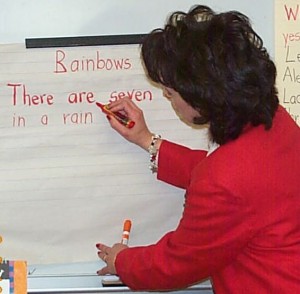
Improving teacher effectiveness has risen to the top of national education priorities, but the key to attracting, training, and retaining truly effective teachers might lie in the “top-third” concept, which seeks to recruit students who perform in the top third of their academic discipline into the teaching profession.
“Closing the talent gap: Attracting and retaining top-third graduates to careers in teaching,” by Byron Auguste, Paul Kihn, and Matt Miller of McKinsey and Co., examines teaching programs and strategies in some of the world’s best-performing nations and seeks to outline how adapting those strategies for practice in the United States might reap enormous benefits for the U.S. economy.
While the world’s top school systems have dedicated approaches to attracting, retaining, and supporting teachers, “the U.S. does not take a strategic or systematic approach to nurturing teacher talent,” the authors state. “We have failed to attract, develop, reward, or retain outstanding professional teaching talent on a consistent basis.”
The report “shines a light on the single factor that impacts student success in schools the most, and that’s the quality of teachers,” said Louis Malfaro, vice president of the American Federation of Teachers and president of Education Austin. It also reveals the “radically different approach” to how teachers are prepared in the highest-performing countries versus how they are prepared in the U.S., he added.
There exists in the U.S. a thought that “teachers don’t need to be smart, they just need to love children. That’s not necessarily a pathway to being effective,” said Kate Walsh, president of the National Council on Teacher Quality. “[We must] persuade districts and states that this is what is good for children.”
Walsh said there tends to be a strong measure of anti-elitism in the U.S., which might eschew highly selective teacher preparation programs on the theory that a teacher does not necessarily have to be highly trained.
“This challenges that assumption, and I think it’s a healthy challenge,” she added.
A global perspective
Top-performing nations recruit 100 percent of their new teachers from the top third of academic performers. In the U.S., only 23 percent of teachers come from the top third of their college class—and in high-poverty schools, this figure is only 14 percent.
These other countries treat education as a highly selective profession, and after recruiting from the top third, they screen those selected students for qualities they believe are indicative of teaching success, such as perseverance and communications skills.
The world’s top-performing school systems in Singapore, Finland, and South Korea recruit, develop, and retain what the report called the “top third+,” or students from the top third of their academic classes from all disciplines, not just students enrolled in teacher preparation programs.
Teacher recruitment in South Korea, Singapore, and Finland is rigorous and highly selective, the authors note, and some programs are government-funded, requiring little or no out-of-pocket expense on students’ behalf.
Singapore offers competitive salaries with retention bonuses at recurring intervals. Its teacher training program accepts roughly 1 in 8 applicants. All teachers have weekly opportunities for professional collaboration and receive 100 hours of paid professional development per year.
Finland’s extremely competitive teaching selection process requires teachers to obtain a master’s degree in a five-year program, and applicants are generally drawn from the top 20 percent of high school graduates. Only 1 in 10 applicants is accepted to become a teacher, and the government pays for teachers’ graduate-level training and a living stipend.
South Korea places deep respect in the teaching profession and offers one of the highest teaching salaries in the world; its “relatively large” class sizes of roughly 35 students on average help teachers there earn salaries equivalent to between $55,000 and $155,000 per year. Teacher turnover is just 1 percent each year.
U.S. views
Researchers talked with teachers and “top third” college students to understand what it would take to attract them to the teaching profession and retain them in the field, as well as what system changes would have to accompany that shift.
McKinsey research of 900 top-third college students and 525 current teachers revealed that most students view teaching as “unattractive in terms of the quality of the people in the field, professional growth, and compensation.”
Of the top-third students who are not planning to enter teaching, most said prestige and compensation are two deterrents.
“Our research suggests that improving compensation and other features of teaching careers could dramatically increase the portion of top-third new hires in high-need schools and school districts, and retain these teachers in much greater numbers with complementary changes, such as better school leaders and working conditions,” the report says.
A separate study, commissioned by Scholastic Inc. and the Bill & Melinda Gates Foundation and released earlier this year, suggests that while higher salaries are important, teachers view money as less important than a supportive leader. Fewer than half of teachers (45 percent) in that earlier study said higher salaries are absolutely essential for retaining good teachers. More teachers said it’s essential to have supportive leadership (68 percent), time to collaborate (54 percent), and high-quality curriculum (49 percent).
The McKinsey report reveals that many education efforts focus on improving the quality of existing classroom teachers, while little attention is paid to attracting college graduates with strong academic performance to the teaching field.
The authors note that U.S. research on whether teachers’ academic backgrounds can predict classroom effectiveness is very mixed, and “merely sprinkling teachers with top-third academic credentials into our existing system will not by itself produce dramatic gains in student achievement.”
“Mentoring and induction programs, and support programs, and not consistent across public education,” Malfaro said.
Some say skilled teachers swim and unskilled teachers sink, and leave the profession, but other successful industries train employees to be successful, he said, adding that U.S. teachers are not consistently supported in how to become successful educators.
“Too often in American public schools, we expect half of our people to leave after five years, and we design systems to ameliorate loss,” he said.
Putting theory into practice
To explore what it would mean to put such global top-third policies into practice in a U.S. context, the nation first would have to identify ways to attract top-third talent to teaching, and then would have to pursue top-third initiatives in cost-effective ways.
The research suggests an immediate need for a shift in teacher recruitment and support in order to attract and retain top graduates to the teaching field.
Education stakeholders would have to examine various areas, “including student-teacher ratios, the basis and structure of teacher compensation over time, and per-pupil school funding formulas and levels” as consideration for a top-third framework begins.
For instance, if the nation accepted higher student-teacher ratios and raised salaries of only the teachers deemed effective by comprehensive evaluations, the cost might be tempered.
The authors state that the nation could explore how to recruit and retain top-third educators with pilot programs in high-needs districts, in an entire state, or perhaps with a “Race to the Top Third” grant competition. Collaborations among districts, and private philanthropic efforts, might reveal other ways to explore initiatives.
They also recommend creating a “National Teaching Talent Plan” in which a commission would propose steps and timelines to implement changes in how the nation recruits, trains, retains, and rewards teachers.
While efforts of this scale will take time—at least 10 years to show measurable results, the authors said—the report states that the social and economic returns could be immense. In fact, recent McKinsey research found that “the achievement gap between the U.S. and top-performing nations—a burden borne most directly by low-income and minority students—imposes the economic equivalent of a ‘permanent national recession’ on the United States.”
Individual school districts, charter schools, and states could partner with universities, teacher unions, entrepreneurs, and the U.S. Department of Education to devise and implement strategies that guarantee effective teachers are the norm, and not the exception.
Portions of the funding needed to cover the cost of teacher preparation programs, to ensure competitive teacher salaries, and to finance other aspects of a top-third teacher system might already exist in schools’ budgets.
“If this is important to you, it forces you to re-prioritize your resources,” said Kaya Henderson, deputy chancellor of the D.C. Public Schools. “We’ve cut some things in the D.C. budget to make room for salary increases, which we think are important.” Philanthropy supports various other city school programs.
“Part of what this report does is force us to think creatively or differently from how we previously approached funding,” she added.
Another rising expense is that of higher education, which Malfaro said would require a national federal financial commitment if the U.S. is serious about bringing the best of its college students into the teaching profession.
Small increases in class size and examining non-teaching costs also might free up essential dollars. Schools often hire instructional coaches, aides, mentors, and other specialists to step in where a classroom teacher cannot, but if the classroom teacher is of a higher caliber, with more training and support, some of those auxiliary staff might not be necessary.
High-poverty schools typically have high teacher turnover and limited resources, and the report notes that the U.S. has a much higher number of schools where all or a large majority of students are economically disadvantaged than do the top nations profiled in the report. But supporting teachers through mentoring, professional development, and compensation could help reduce the high turnover rate in high-poverty schools.
Examining the U.S.’s teacher preparation and recruitment comes at an opportune time, the authors say, because more than half of today’s teachers will be eligible for retirement in the next 10 years; high-poverty schools struggle to attract great teachers, especially those in science, technology, engineering, and math; and it is more important than ever for students to be well-equipped with 21st-century skills.
- Educators love their edtech, but want more training - April 18, 2024
- Friday 5: College and career readiness - April 12, 2024
- Cybersecurity: eSN Innovation Roundtable - April 11, 2024


Comments are closed.